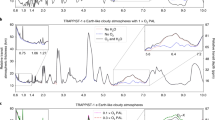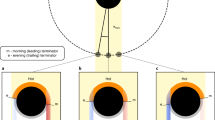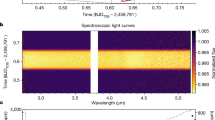Abstract
Oxygen is a constituent of many of the most abundant molecules detected in exoplanetary atmospheres and a key ingredient for tracking how and where a planet formed1. In particular, the O i 777.4 nm triplet is used to probe airglow and aurora on the Earth2 and the oxygen abundance in stellar atmospheres3,4,5,6, but has not been detected in an exoplanet atmosphere before. We present a definite ground-based detection of the neutral oxygen 777.4 nm triplet lines in the transmission spectrum of the ultrahot Jupiter KELT-9b7, the hottest known giant planet. The synthetic spectrum computed employing novel non-local thermodynamic equilibrium radiative transfer calculations8 matches the data significantly better than that computed assuming local thermodynamic equilibrium. These non-local thermodynamic equilibrium radiative transfer calculations imply a mass-loss rate of 108–109 kg s−1, which exceeds the lower limit of 107–108 kg s−1 required to facilitate the escape of oxygen and iron from the atmosphere. Assuming a solar oxygen abundance, the non-local thermodynamic equilibrium model points towards the need for microturbulence and macroturbulence broadening of 3.0 ± 0.7 km s−1 and 13 ± 5 km s−1, respectively, indicative of the presence of fast winds in the middle and upper atmosphere. Present and upcoming high-resolution spectrographs will allow the detection in other exoplanets of the 777.4 nm O i triplet, which is a powerful tool to constrain the key characteristics of exoplanetary atmospheres when coupled with forward modelling accounting for non-local thermodynamic equilibrium effects.
This is a preview of subscription content, access via your institution
Access options
Access Nature and 54 other Nature Portfolio journals
Get Nature+, our best-value online-access subscription
$29.99 / 30 days
cancel any time
Subscribe to this journal
Receive 12 digital issues and online access to articles
$119.00 per year
only $9.92 per issue
Buy this article
- Purchase on Springer Link
- Instant access to full article PDF
Prices may be subject to local taxes which are calculated during checkout




Similar content being viewed by others
Data availability
Data used in this work are publicly available from the Calar Alto archive at http://caha.sdc.cab.inta-csic.es/calto/.
Code availability
The spectral reduction was done with a self-written IDL script. The stellar model spectrum used for the stellar contamination impact was obtained with the Spectroscopy Made Easy tool, which is publicly available from http://www.stsci.edu/~valenti/sme.html. The DE-MCMC routines were taken from EXOFAST, publicly available at https://github.com/jdeast/EXOFASTv2.
References
Madhusudhan, N. Exoplanetary atmospheres: key insights, challenges, and prospects. Annu. Rev. Astron. Astrophys. 57, 617–663 (2019).
Mendillo, M., Withers, P. & Dalba, P. A. Atomic oxygen ions as ionospheric biomarkers on exoplanets. Nat. Astron. 2, 287–291 (2018).
Kiselman, D. The 777 nm oxygen triplet in the Sun and solar-type stars, and its use for abundance analysis. Astron. Astrophys. 275, 269–282 (1993).
Przybilla, N., Butler, K., Becker, S. R., Kudritzki, R. P. & Venn, K. A. Non-LTE line formation for neutral oxygen. Model atom and first results on A-type stars. Astron. Astrophys. 359, 1085–1106 (2000).
Steffen, M. The photospheric solar oxygen project. IV. 3D-NLTE investigation of the 777 nm triplet lines. Astron. Astrophys. 583, A57 (2015).
Sitnova, T. M. & Mashonkina, L. I. Influence of inelastic collisions with hydrogen atoms on non-LTE oxygen abundance determinations. Astron. Lett. 44, 411–419 (2018).
Gaudi, B. S. et al. A giant planet undergoing extreme-ultraviolet irradiation by its hot massive-star host. Nature 546, 514–518 (2017).
Fossati, L. et al. Non-local thermodynamic equilibrium effects determine the upper atmospheric temperature structure of the ultrahot Jupiter KELT-9b. Astron. Astrophys. 653, A52 (2021).
Yan, F. & Henning, T. An extended hydrogen envelope of the extremely hot giant exoplanet KELT-9b. Nat. Astron. 2, 714–718 (2018).
Cauley, P. W. et al. Atmospheric dynamics and the variable transit of KELT-9 b. Astrophys. J. 157, 69 (2019).
Turner, J. D. et al. Detection of ionized calcium in the atmosphere of the ultrahot Jupiter KELT-9b. Astrophys. J. 888, L13 (2020).
Wyttenbach, A. et al. Mass-loss rate and local thermodynamic state of the KELT-9 b thermosphere from the hydrogen Balmer series. Astron. Astrophys. 638, A87 (2020).
Hoeijmakers, H. J. et al. Atomic iron and titanium in the atmosphere of the exoplanet KELT-9b. Nature 560, 453–455 (2018).
Hoeijmakers, H. J. et al. A spectral survey of an ultrahot Jupiter. Detection of metals in the transmission spectrum of KELT-9 b. Astron. Astrophys. 627, A165 (2019).
Pino, L. et al. Neutral iron emission lines from the dayside of KELT-9b: the GAPS Program with HARPS-N at TNG XX. Astrophys. J. 894, L27 (2020).
Borsa, F. et al. The GAPS Programme with HARPS-N at TNG. XIX. Atmospheric Rossiter–McLaughlin effect and improved parameters of KELT-9b. Astron. Astrophys. 631, A34 (2019).
Lothringer, J. D., Barman, T. & Koskinen, T. Extremely irradiated hot Jupiters: non-oxide inversions, H− opacity, and thermal dissociation of molecules. Astrophys. J. 866, 27 (2018).
Fossati, L. et al. A data-driven approach to constraining the atmospheric temperature structure of the ultrahot Jupiter KELT-9b. Astron. Astrophys. 643, A131 (2020).
García Muñoz, A. & Schneider, P. C. Rapid escape of ultrahot exoplanet atmospheres driven by hydrogen Balmer absorption. Astrophys. J. 884, L43 (2019).
Quirrenbach, A. et al. CARMENES instrument overview. Proc. SPIE 9147, 91471F (2014).
Borsa, F. & Zannoni, A. Stellar contributions to the line profiles of high-resolution transmission spectra of exoplanets. Astron. Astrophys. 617, A134 (2018).
Casasayas-Barris, N. et al. Is there Na i in the atmosphere of HD 209458b? Effect of the centre-to-limb variation and Rossiter–McLaughlin effect in transmission spectroscopy studies. Astron. Astrophys. 635, A206 (2020).
Lecavelier des Etangs, A., Vidal-Madjar, A., McConnell, J. C. & Hébrard, G. Atmospheric escape from hot Jupiters. Astron. Astrophys. 418, L1–L4 (2004).
Li, S. L., Miller, N., Lin, D. N. C. & Fortney, J. J. WASP-12b as a prolate, inflated and disrupting planet from tidal dissipation. Nature 463, 1054–1056 (2010).
Guo, J. H. Escaping particle fluxes in the atmospheres of close-in exoplanets. II. Reduced mass-loss rates and anisotropic winds. Astrophys. J. 766, 102 (2013).
Tan, X. & Komacek, T. D. The atmospheric circulation of ultrahot Jupiters. Astrophys. J. 886, 26 (2019).
Vidal-Madjar, A. et al. Detection of oxygen and carbon in the hydrodynamically escaping atmosphere of the extrasolar planet HD 209458b. Astrophys. J. 604, L69 (2004).
Ben-Jaffel, L. & Ballester, G. E. Hubble Space Telescope detection of oxygen in the atmosphere of exoplanet HD 189733b. Astron. Astrophys. 553, A52 (2013).
Caballero, J. A. et al. CARMENES: data flow. Proc. SPIE 9910, 99100E (2016).
Zechmeister, M., Anglada-Escudé, G. & Reiners, A. Flat-relative optimal extraction. A quick and efficient algorithm for stabilised spectrographs. Astron. Astrophys. 561, A59 (2014).
Bauer, F. F., Zechmeister, M. & Reiners, A. Calibrating echelle spectrographs with Fabry–Pérot etalons. Astron. Astrophys. 581, A117 (2015).
Wyttenbach, A., Ehrenreich, D., Lovis, C., Udry, S. & Pepe, F. Spectrally resolved detection of sodium in the atmosphere of HD 189733b with the HARPS spectrograph. Astron. Astrophys. 577, A62 (2015).
Snellen, I. A. G., Albrecht, S., de Mooij, E. J. W. & Le Poole, R. S. Ground-based detection of sodium in the transmission spectrum of exoplanet HD 209458b. Astron. Astrophys. 487, 357–362 (2008).
Vidal-Madjar, A. et al. The Earth as an extrasolar transiting planet. Earth’s atmospheric composition and thickness revealed by Lunar eclipse observations. Astron. Astrophys. 523, A57 (2010).
Astudillo-Defru, N. & Rojo, P. Ground-based detection of calcium and possibly scandium and hydrogen in the atmosphere of HD 209458b. Astron. Astrophys. 557, A56 (2013).
Yan, F., Pallé, E., Fosbury, R. A. E., Petr-Gotzens, M. G. & Henning, T. Effect of the stellar absorption line centre-to-limb variation on exoplanet transmission spectrum observations. Astron. Astrophys. 603, A73 (2017).
Piskunov, N. & Valenti, J. A. Spectroscopy Made Easy: evolution. Astron. Astrophys. 597, A16 (2017).
Ryabchikova, T. et al. A major upgrade of the VALD database. Phys. Scr. 90, 054005 (2015).
Brogi, M. et al. Rotation and winds of exoplanet HD 189733 b measured with high-dispersion transmission spectroscopy. Astrophys. J. 817, 106 (2016).
Palle, E. et al. Transmission spectroscopy and Rossiter–McLaughlin measurements of the young Neptune orbiting AU Mic. Astron. Astrophys. 643, A25 (2020).
Benatti, S. et al. Constraints on the mass and atmospheric composition and evolution of the low-density young planet DS Tuc A b. Astron. Astrophys. 650, A66 (2021).
Ter Braak, C. J. F. A Markov chain Monte Carlo version of the genetic algorithm Differential Evolution: easy Bayesian computing for real parameter spaces. Stat. Comput. 16, 239 (2006).
Eastman, J., Gaudi, B. S. & Agol, E. EXOFAST: a fast exoplanetary fitting suite in IDL. Publ. Astron. Soc. Pac. 125, 83–112 (2013).
Hunten, D. M., Pepin, R. O. & Walker, J. C. G. Mass fractionation in hydrodynamic escape. Icarus 69, 532–549 (1987).
Koskinen, T. T., Yelle, R. V., Lavvas, P. & Cho, J. Y.-K. Electrodynamics on extrasolar giant planets. Astrophys. J. 796, 16 (2014).
Acknowledgements
F.B. acknowledges support from PLATO ASI-INAF agreement 2015-019-R.1-2018. This research has made use of the Spanish Virtual Observatory (http://svo.cab.inta-csic.es) supported by the MINECO/FEDER through grant AyA2017-84089.7. T.K. acknowledges support by the NASA Exoplanet Research Program grant 80NSSC18K0569. D.S. acknowledges financial support from the State Agency for Research of the Spanish MCIU through the Center of Excellence Severo Ochoa award to the Instituto de Astrofísica de Andalucía (SEV-2017-0709). M.E.Y. acknowledges funding from the European Research Council (ERC) under the European Union’s Horizon 2020 research and innovation programme under grant agreement 805445.
Author information
Authors and Affiliations
Contributions
F.B. carried out the data analysis. L.F. and T.K. performed the theoretical calculations. F.B., L.F. and T.K. contributed to the writing of the manuscript. All authors contributed to the interpretation of the data and the results.
Corresponding author
Ethics declarations
Competing interests
The authors declare no competing interests.
Additional information
Peer review information Nature Astronomy thanks Matteo Brogi and Fei Yan for their contribution to the peer review of this work.
Publisher’s note Springer Nature remains neutral with regard to jurisdictional claims in published maps and institutional affiliations.
Supplementary information
Supplementary Information
Supplementary Figs. 1–6 and Table 1.
Rights and permissions
About this article
Cite this article
Borsa, F., Fossati, L., Koskinen, T. et al. High-resolution detection of neutral oxygen and non-LTE effects in the atmosphere of KELT-9b. Nat Astron 6, 226–231 (2022). https://doi.org/10.1038/s41550-021-01544-4
Received:
Accepted:
Published:
Issue Date:
DOI: https://doi.org/10.1038/s41550-021-01544-4
This article is cited by
-
Oxygen as atmospheric thermometer
Nature Astronomy (2022)



